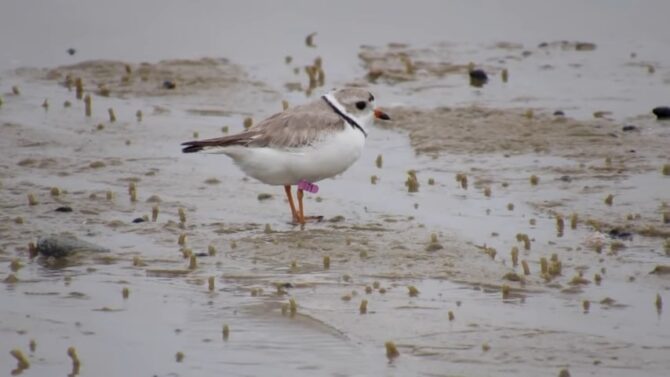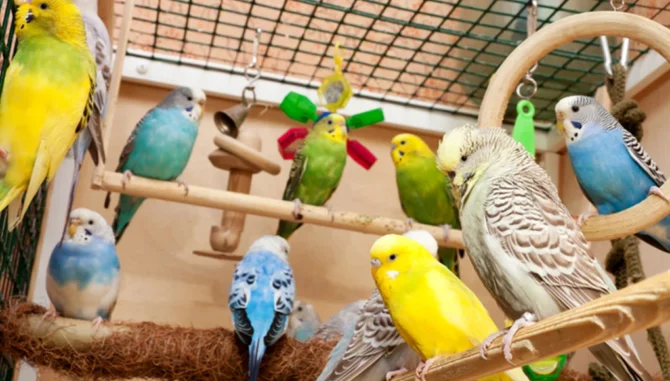Birds have always captured the human imagination with their vibrant colors, melodious songs, and the sheer diversity of species. Among the vast array of avian species, small birds, in particular, have a unique charm that often goes unnoticed due to their diminutive size.
However, these tiny wonders play a crucial role in maintaining ecological balance and are a testament to nature’s intricate design. In this article, we will delve into the world of ten types of small birds, shedding light on their characteristics, habitats, and behaviors.
Hummingbirds: Nature’s Helicopters
Size: 3-5 inches
Description: Hummingbirds are truly one of nature’s most fascinating avian species. Their rapid wing beats, which can exceed 50 beats per second, allow them to hover in place, dart forward, or even fly backward—a feat no other bird can achieve. Their dazzling, iridescent feathers shimmer in sunlight, making them look like flying jewels. Equipped with a high metabolism, they feed frequently, sipping nectar from flowers with their long, specialized bills and catching insects in mid-air. Their incredible energy and agility are a testament to nature’s design.
Habitat: Mostly found in the Americas, from Alaska to Tierra del Fuego.
Sparrows: The Ubiquitous Songsters

Size: 4-7 inches
Description: Often overlooked due to their common appearance, sparrows are cute small birds with a big presence. Their stout bodies are covered in brownish or grayish plumage, often with subtle patterns that vary by species. Their melodious songs, which can vary greatly among species, fill the air, especially during the breeding season. Sparrows are highly adaptable and can be found in a variety of habitats, from urban areas to remote countrysides. They primarily feed on seeds but won’t shy away from insects, especially when feeding their young.
Habitat: Found worldwide, except for the polar regions. They thrive in urban areas, farmlands, and forests.
Finches: The Seed Eaters

Size: 3-6 inches
Description: Finches are lively birds, often seen flitting about in flocks. Their strong, conical beaks are perfectly designed for cracking open seeds, their primary diet. The diversity in finch species is vast, with variations in size, color, and song. Some species, like the Goldfinch, sport vibrant yellow and black plumage, while others, like the House Finch, have more muted tones. Their cheerful songs and active nature make them a delight to observe.
Habitat: They inhabit a range of environments, including gardens, woodlands, and grasslands across the globe.
Warblers: The Migratory Minstrels

Size: 4-5 inches
Description: Warblers are a diverse group of small, often colorful birds. They are known for their melodious and complex songs, which can sometimes be challenging to differentiate. During the breeding season, male warblers sing tirelessly to establish territories and attract mates. These birds are also known for their long migratory journeys, with some species traveling thousands of miles between their breeding and wintering grounds. Their vibrant colors and active behavior make them a favorite among birdwatchers.
Habitat: Primarily found in North America, they migrate to Central and South America during winter.
Wrens: The Energetic Explorers

Size: 3-5 inches
Description: Wrens are small but full of energy. Their brownish plumage might seem plain at first glance, but their loud, complex songs give away their presence. These birds are curious and fearless, often venturing into nooks and crannies in search of insects, their primary diet. Their tails, often held upright, and their quick movements are characteristic behaviors that make them easily recognizable.
Habitat: They prefer woodlands, gardens, and shrubs. Wrens are primarily found in the Americas.
Chickadees: The Cheerful Chirpers
Size: 4-6 inches
Description: Chickadees are small, round birds with a distinctive black cap and bib contrasted against their white cheeks. Their name is onomatopoeic, derived from their distinctive “chick-a-dee-dee-dee” call, which can change in intensity and length depending on whether they’re expressing curiosity, giving an alarm call, or identifying themselves. They are highly social birds, often seen in flocks, especially during the winter.
Habitat: Native to North America, they inhabit forests, woodlands, and gardens.
Titmice: The Tufted Treasures

Size: 5-6 inches
Description: Titmice, with their prominent tufted crests, are closely related to chickadees and share many behavioral traits with them. Their soft, silvery-gray plumage is often punctuated with areas of rust or peach-colored feathers, depending on the species. They are curious and bold, often one of the first birds to visit a feeder and are known to hoard food in hiding spots to consume later.
Habitat: Found in woodlands, gardens, and parks across North America.
Kinglets: The Crowned Jewels

Size: 3-4 inches
Description: Kinglets are tiny, restless birds that are constantly on the move. They possess a distinctive crown patch, which can be orange or yellow, and is often only visible when raised. Their flitting movements as they search for insects on tree branches and their high-pitched songs are characteristic. Despite their small size, they are hardy birds, with some species braving the cold winters of the northern regions.
Habitat: They prefer coniferous forests and migrate to warmer regions during winters.
Nuthatches: The Tree Climbers
Size: 4-5 inches
Description: Nuthatches are unique in the avian world due to their behavior of climbing down trees headfirst, a feat not shared by many birds. Their strong, pointed bills are perfect for probing into tree bark crevices to extract hidden insects. Their name is derived from their habit of jamming large nuts into tree bark and then “hatching” them out with their beaks.
Habitat: They are found in forests and woodlands across the Northern Hemisphere.
Plovers: The Shoreline Sprinters

Size: 5-7 inches
Description: Plovers are small, roundish wading birds with short bills and webbed feet. They are known for their characteristic “run-stop-peck” behavior as they dash about on shorelines and mudflats in search of food. Their sharp, pointed bills are perfect for picking up insects, worms, and crustaceans. Many species have distinctive facial markings and bands, making them identifiable even at a distance.
Habitat: They are commonly found along coastlines, wetlands, and grasslands worldwide.
FAQs
Why are some birds smaller in size compared to others?
Answer: Bird sizes have evolved over time based on various ecological and evolutionary pressures. Smaller sizes in certain species can be advantageous for rapid maneuverability, accessing specific food sources like tiny insects, or nesting in tight spaces. Additionally, smaller birds often have faster metabolic rates, which can be beneficial in certain environments.
How do small birds defend themselves from predators?
Answer: Small birds employ various defense mechanisms. These include camouflage, where their plumage blends in with their surroundings; alarm calls to alert other birds of danger; rapid and agile flight patterns to evade predators; and even mobbing behavior, where groups of small birds harass a larger predator to drive it away.
What is the average lifespan of these small birds?
The lifespan of small birds varies widely based on species, environmental factors, and threats from predators. While many small birds, like warblers or chickadees, might live 2-5 years in the wild, others, especially when protected from predators and given ample food, can live longer. For instance, some captive hummingbirds have been known to live up to 9 years.
How do these small birds cope with harsh weather conditions, especially during winters?
Small birds have developed various strategies to survive in harsh conditions. Many migrate to warmer regions during winters, while others have specialized behaviors like torpor (a hibernation-like state) to conserve energy. They also fluff up their feathers to trap air and insulate themselves, and some species even huddle together for warmth.
Do small birds have a specific mating ritual or behavior?
Yes, many small birds have unique mating rituals. These can include intricate songs, dance-like displays, or even aerial acrobatics. Such behaviors help them attract mates and signal their fitness as potential partners. For instance, male hummingbirds often perform impressive dive displays to woo females.
How do small birds communicate with each other?
Small birds use a combination of vocalizations and physical displays to communicate. Their calls can convey a range of messages, from warning of nearby predators to signaling their availability for mating. Some species also use body language, like puffing up their feathers or spreading their wings, to convey specific emotions or intentions.
Conclusion
The world of small birds is vast and diverse, with each species offering a unique glimpse into the wonders of nature. Whether it’s the hovering dance of the hummingbird or the cheerful chirp of the chickadee, these tiny avian wonders enrich our world in countless ways. The next time you’re out in nature, take a moment to appreciate these small wonders. Their beauty, resilience, and role in the ecosystem serve as a reminder of the intricate web of life that connects us all.






